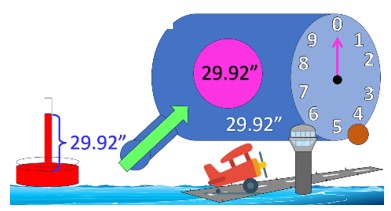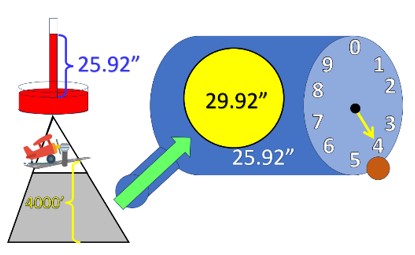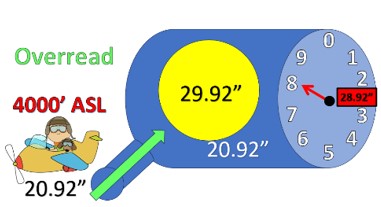By John Picone, PPL / INRAT Ground School Instructor, Brantford Flight Center
This quest for understanding something, being able to conceptualize it, is especially evident in me as a ground school instructor. And whether it’s the aerodynamics of a tailplane stall, accounting for carburetor ice even when the outside air temperature is +30°C, or why a pilot corrects to the right passing through a front, I want my students to understand, not just memorize the facts. How many pilots might still be alive if they had had a deep understanding of load factor and stall speed on that slow turn from base to final?
One area where understanding is important is altimetry. “High to low, look out below!” is certainly a good mnemonic, but an understanding of what lies behind this axiom is crucial. Helping students conceptualize how the altimeter works and how it changes is, for me, most uplifting (get it?).
Earlier in the course, students have already conceptualized that air is made up of molecules and that, due to gravity being stronger close to the earth’s surface, the higher we go, the fewer air molecules there are. Also, those air molecules up high are pushing down on their buddies underneath. The closer the molecules are to the surface of the earth, the higher the pressure; the farther away the molecules are from earth’s surface, the lower the pressure. The class is also already familiar with the mercury barometer, the International Standard Atmosphere (ISA) standards of temperature and pressure at the sea level datum as well as the standard pressure and temperature lapse rates from that datum. Add to this an understanding of the rudiments of the pitot-static system, and the stage is set to explore altimeter setting errors and the consequences thereof.
Now, how does the sensitive altimeter (has a Kollsman window or a subscale) work with this air behaviour to accurately tell us how high we are? And what are the consequences if a pilot neglects to adjust the altimeter appropriately?
Step one is for students to understand just how the altimeter works. While the precise designation is “aneroid capsule,” I tell the class that the altimeter is simply a box with a balloon inside. It really doesn’t measure altitude but rather changes in pressure. Then, through the magic of linkages, needles and numbers on a dial, it converts changes in pressure to changes in altitude. Through the static port, the air in the box that surrounds the balloon is connected to the ambient air; that is, the air the plane is in at any given moment whether on the ground or in the sky. The pressure in the balloon is always the same. It pushes on the balloon wall with a pressure of 29.92” Hg (inches of mercury). The pressure surrounding the balloon changes as the pressure of the ambient air changes.
Image A
Imagine a balloon inflated at the bottom of a swimming pool to a particular size. Let’s imagine that the pressure inside the balloon is the same as the pressure of the water surrounding it (Image A). Now, if we allow the balloon to rise closer to the surface of the pool where the water pressure is less (Image B), then, because the pressure inside the balloon has remained constant, it will expand. The altimeter works in exactly the same way: the pressure inside the balloon/aneroid capsule remains constant and expands or contracts as the pressure of the surrounding air allows.
Image B
Figure 1: Airplane icon by SmashIcons. Airport image by ClipArt Library
Let’s look at the scenario in Figure 1: a sea-level airport on a day when the barometric pressure is 29.92” Hg. It just happens to be that one day of the century when we have a standard pressure day! The pressure in the altimeter box matches the pressure in the aneroid balloon and the needle says we’re at an altitude of “0” ft above sea level (ASL). If our pilot flies to and lands at a mountaintop field, with an aerodrome elevation of 4 000 ft ASL, the outside barometric pressure, and hence the pressure in the altimeter box, will drop. In this instance, as shown in Figure 2, the pressure has dropped 4” of mercury to 25.92” Hg, corresponding to our standard lapse rate of 1” Hg for every 1 000 ft. Naturally, the aneroid balloon will expand and, linked to the dial, will give an indication of 4 000 ft ASL.
Figure 2
But this is all in a standard atmosphere where the mean sea level pressure is 29.92” Hg. But what happens when the mean sea level (MSL) pressure is NOT standard, when it’s greater or less than the pressure in the aneroid balloon? Let’s return to our sea-level aerodrome.
Figure 3
What we see in Figure 3 is that the barometric pressure at the airport—often referred to as Station Pressure—is now 2” Hg less than Standard Pressure: 27.92” Hg. 2” equals 2 000 ft, and so when the aneroid balloon expands, the needle indicates 2 000 ft. Which makes sense, since lower pressure—fewer air molecules—is higher. “Except,” cogitates our pilot, “I’m NOT higher! I’m still at sea level!” And this is where Mr. Paul Kollsman comes in! He invented the sensitive altimeter in 1928.
Turning the knob and moving the scale in the Kollsman window actually rotates the entire inside mechanism of the altimeter. In this instance, rotating the dial until the MSL of 27.92” Hg shows in the subscale will turn the needle back to “0,” which is the correct altitude, as seen in Figure 4.
Although this is not a practice we use in aviation, another way to explain how the altimeter works is to ask the students what the Kollsman window would display if, no matter at what altitude an airport was located, we set the needle to “0”? In this instance, we are comparing the pressure in the aneroid balloon—29.92” Hg—to the pressure in the box, which is the outside air pressure as measured with a barometer. The scenario is the same as in Figure 4: the subscale would indicate the outside barometric pressure, or Station Pressure. This is sometimes referred to as QFE, “FE” an abbreviation for “field elevation.”
Figure 4
Now, if we were to do this—set the altimeter to “0”—at our mountain airport in Figure 2, we would read the Station Pressure of 25.92” Hg. But that pressure is idiosyncratic to that airport; it wouldn’t help much if we were taking off from here and landing at an airport with a different altitude. So, to keep us all on the same page, as it were, we need to set our altimeters with reference to a different datum–sea level, which is common to all aircraft flying in the area. This will keep us from bumping into each other. To find out what this sea level datum is, we simply turn the knob until the needle indicates the airport elevation. In other words, like Paul Kollsman in 1928, we are seeking a way to adjust the altimeter to account for changes in barometric pressure due to airport elevation. Adding 4 000 ft of airport elevation adds 4” to the indicated pressure in the subscale, and we get our sea level pressure of 29.92” Hg as in Figure 5. This is referred to as QNH, “NH” an abbreviation for “nautical height.” We usually refer to this as the “altimeter setting,” and it’s the number we read in a METAR weather report. It’s useful to know this relationship between station pressure and airport elevation; when flying out of an airport where no altimeter setting is readily available from a local weather station, simply setting the altimeter to the field elevation will give the QNH in the Kollsman window. Essentially, converting the field elevation ASL into inches of mercury will give the difference between the Station Pressure QFE and the Altimeter Setting QNH. In Figure 5, the difference is 4”; the field elevation is 4 000 ft. True altitude equals indicated altitude.
Figure 5
So, what about the errors a pilot can make in adjusting—or failing to adjust—the number in the Kollsman window? What are the consequences of having an inaccurate QNH? The fact is that, while the pressure in the aneroid balloon remains the same at 29.92” Hg, the ambient pressure entering the altimeter through the static port changes. Not only from day to day, but quite possibly from takeoff to destination. A useful way to approach this is to personify the altimeter: “At what altitude,” asks Albert the Altimeter, “do I think I’m flying?”
Figure 6
Image with permission of KindPNG
Let’s consider the scenario presented in Figure 6. Albert is at a TRUE altitude of 6 000 ft ASL; the QNH altimeter setting is 28.92” Hg; the outside barometric pressure is 22.92” Hg. The difference between the barometric pressure and the QNH is 6 inches; the needle registers 6 000 ft and Albert is flying at 6 000 ft ASL. Everything is accurate! TRUE altitude equals INDICATED altitude.
But let’s attend to the consequences if Albert, in his flight from Brantford to Ottawa, flies to a region of higher pressure and neglects to update his altimeter setting with a revised QNH. In Figure 7, we see that the higher barometric pressure—entering the altimeter through the static line—is now 2” greater than it was at departure: 24.92” Hg. The increased pressure causes the aneroid balloon to shrink, and the needle goes down.
If Albert had checked with air traffic control (ATC) for a current QNH, he would have found it to be likewise 2” higher: 30.92” Hg. But Albert didn’t make the adjustment and, as we can see, the difference between the outside barometric pressure and the altimeter setting is 4”; the altimeter underreads by 2 000 ft: there’s the error of two inches! So, Albert the Altimeter “thinks” he’s flying at 4 000 ft ASL and climbs 2 000 ft until he reaches his desired altitude of 6 000 ft indicated. I say “indicated” because that’s only what’s indicated! It is NOT Albert’s TRUE altitude which is now 8 000 ft ASL. TRUE altitude does NOT equal INDICATED altitude. In flying from a low-pressure region to a high-pressure region—without making an adjustment—the altimeter will underread, and the pilot will compensate by flying too high.
Figure 7
Figure 8
While this is bad enough, the reverse scenario—depicted in Figure 8—can be deadly; flying from a high-pressure region to a low-pressure region: the static pressure in the box diminishes and the aneroid balloon expands. In failing to adjust the altimeter setting QNH to the lower pressure—26.92” Hg—the altimeter now overreads: the difference between the number in the Kollsman window and the actual barometric pressure entering the altimeter through the static port is now 8”: 28.92” minus 20.92”. The needle indicates 8 000 ft, which is 2 000 ft higher than Albert wants to fly. Consequently, Albert descends to an indicated altitude of 6 000 ft when his true altitude is now 4 000 ft ASL.
As one can easily imagine, these altimeter setting errors can have serious consequences for joining a circuit and landing: an overshoot or an undershoot are on the horizon! The second scenario—when pressure changes from high to low—is particularly dangerous for obvious reasons, especially when flying in Instrument Meteorological Conditions (IMC–IFR). Flying too low can lead to CFIT: controlled flight into terrain.
The change from high to low not only pertains to changes in barometric pressure. The change from high temperature to low temperature is also a factor in altimeter setting error. Pressure levels change more quickly in cold weather; air molecules are closer together and the air has a higher density.
Figure 9
The pilot in Figure 9 is dialled in an accurate altimeter setting—QNH—on departure; the altimeter “thinks” it is at 6 000 ft ASL. While the QNH remains accurate throughout the flight, one can see how a change in temperature (exaggerated in this instance) can exacerbate the discrepancy between INDICATED altitude and TRUE altitude. This is why pilots apply Cold Weather Corrections to important altitudes especially in the world of instrument flight rules. The FAA in the United States even has a list of Cold Temperature Restricted Airports (CTRA).
The advent of such technologies as ADS-B permit ATC to bring aircraft ever closer together. Eradicating altimeter setting errors has never been more paramount. The pressure is on!










